AI, design me a thriving downtown Seattle
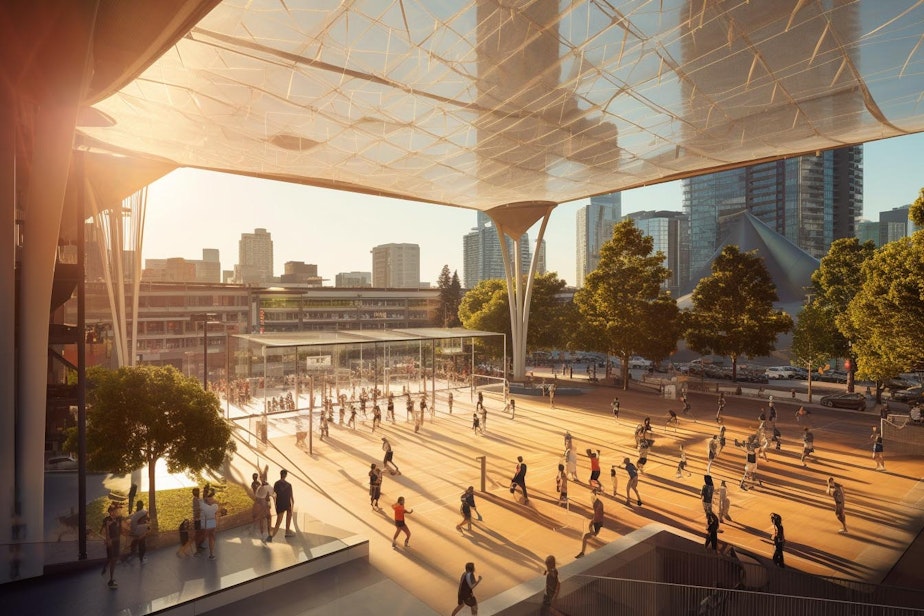
Seattle Mayor Bruce Harrell used AI to build enthusiasm for Space-Needle-sized ideas for downtown, but protesters almost drowned him out.
Mayor Harrell's downtown activation plan features near-term strategies such as "improving street and sidewalk lighting in areas of downtown where crime and disorder are concentrated." It includes proposed zoning changes that would encourage more housing and even a school downtown.
These proposals are important and we will get to them. But it was protesters and artificial intelligence that stole the show.
During the mayor's big press event in Westlake Park on Wednesday, protesters shouted "Stop the Sweeps," causing him to visibly lose his focus a couple of times.
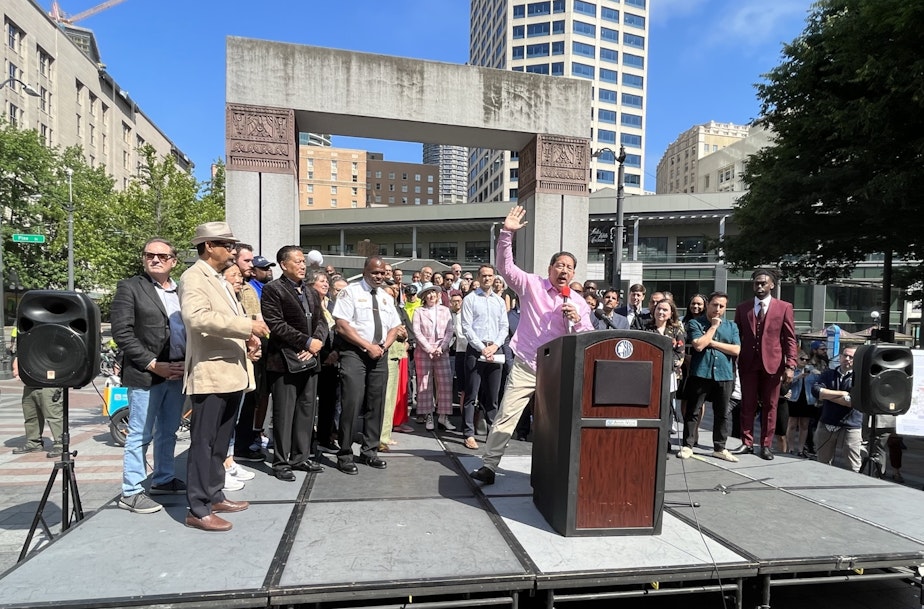
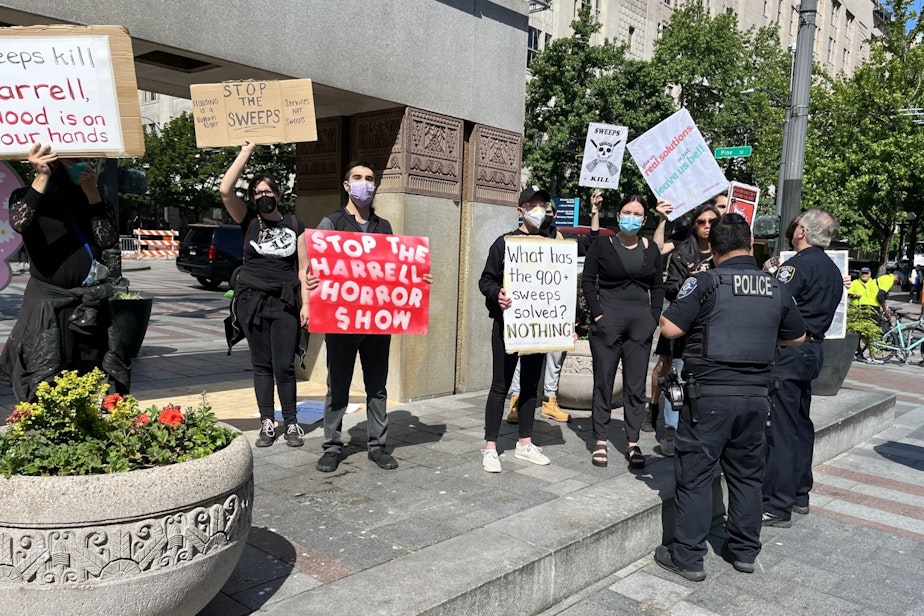
Later, some protesters explained their critique, though none agreed to share their names. One said that RVs in the SODO area have been pushed out in anticipation of the coming All-Star Game, not using established outreach services, but using increasingly stringent parking enforcement practices.
"The city’s response is just simply to sweep them to the margins where they go die alone," one protester said.
W
hile Mayor Harrell struggled at times to communicate his vision over the chants, he was aided in his efforts by AI. His office tasked the architecture firm Olson Kundig to create renderings of imaginary buildings and neighborhoods that could define the Seattle of the future, much as the Space Needle defines Seattle today. Olson Kundig turned to third party AI tools.
The resulting images are visible on a website that launched the moment his conference began. They should not be understood as real projects: No one even knows where these facilities would go, or how they'd be funded, or if they're even the right ideas.
Sponsored
Nevertheless, they demonstrate the scale the mayor is thinking, even if it takes a thousand small legislative maneuvers and years of fundraising to get there.
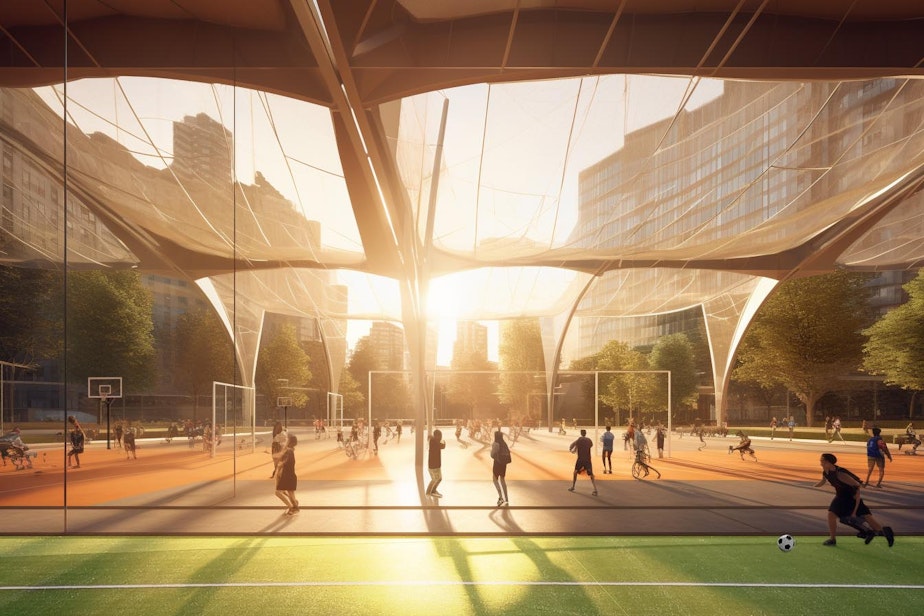
Giant umbrella for sports
Harrell described a "state of the art sports and recreation facility" that would bring together "people of all ages, families, and professional and amateur players alike to connect through sports, play, and fun." The AI engine created images for what looks like a giant glass umbrella covering a city block full of people playing soccer and basketball. In a press briefing on Tuesday, city staff offered the example of a multi-level pickleball complex in Los Angeles.
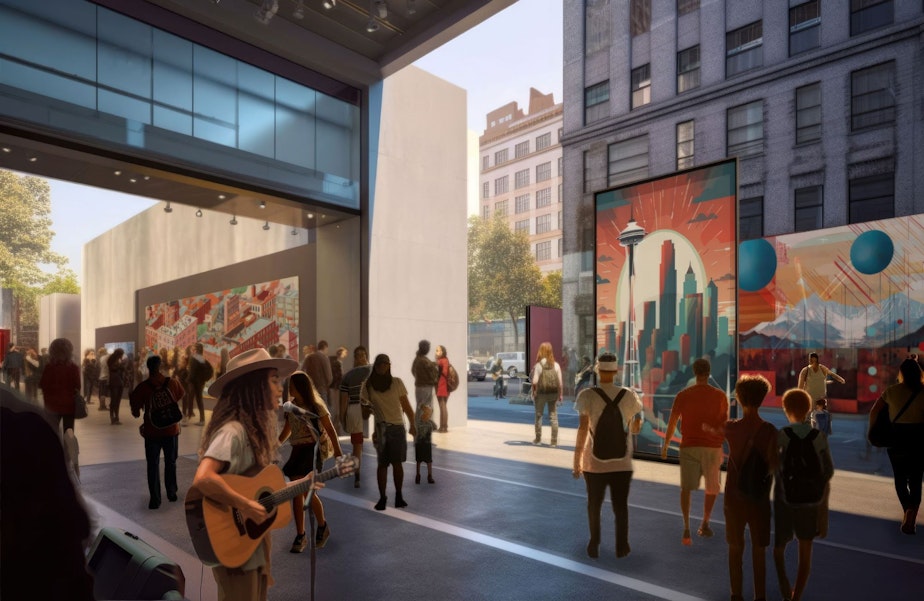
Sponsored
Downtown Arts, Culture and Entertainment District
This is an idea promoted by Greg Spotts, director of the Seattle Department of Transportation: that the streetcar connector line running through downtown could become the spine for a linear arts, culture and entertainment district.
The mayor's staff emphasized in a briefing that this district could begin taking form even before the Streetcar Connector line is built. They're pursuing additional funding for it now.
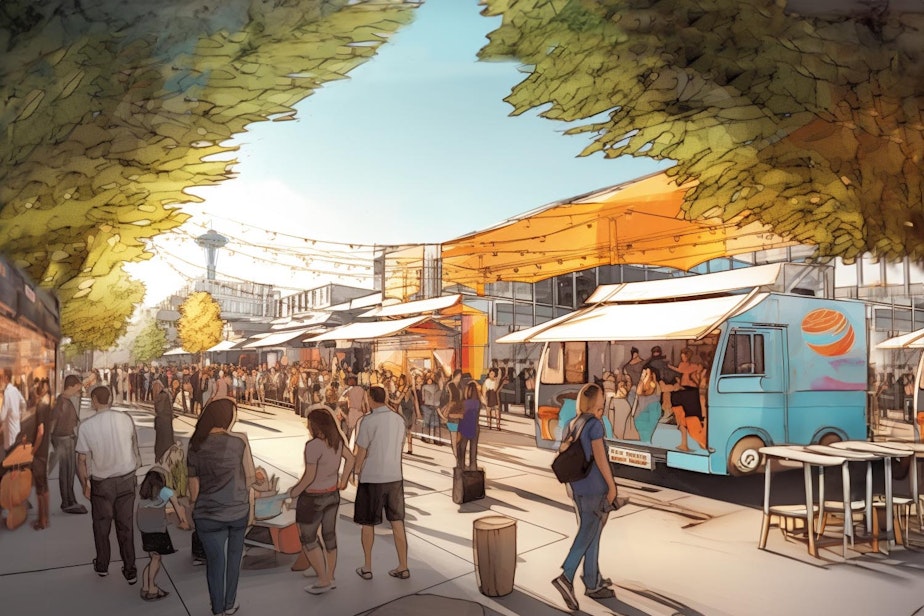
The Mercado
The mayor and his office of Economic Development Director Markham McIntyre described a sort of "Pike Place Market II" focusing on Black, Indigenous and Communities of Color. While the existing market does include diverse business owners, this facility might include a commercial kitchen to help new food businesses expand their operations.
Combine this idea with more leniency the mayor intends to give to food trucks, and a block of Pike Street between 1st and 2nd Avenue the city has now closed to encourage pedestrian activity, and you can imagine how the entrepreneurship of the Pike Place Market could begin to spread into the rest of downtown, sharing the growing wealth with BIPOC business owners.
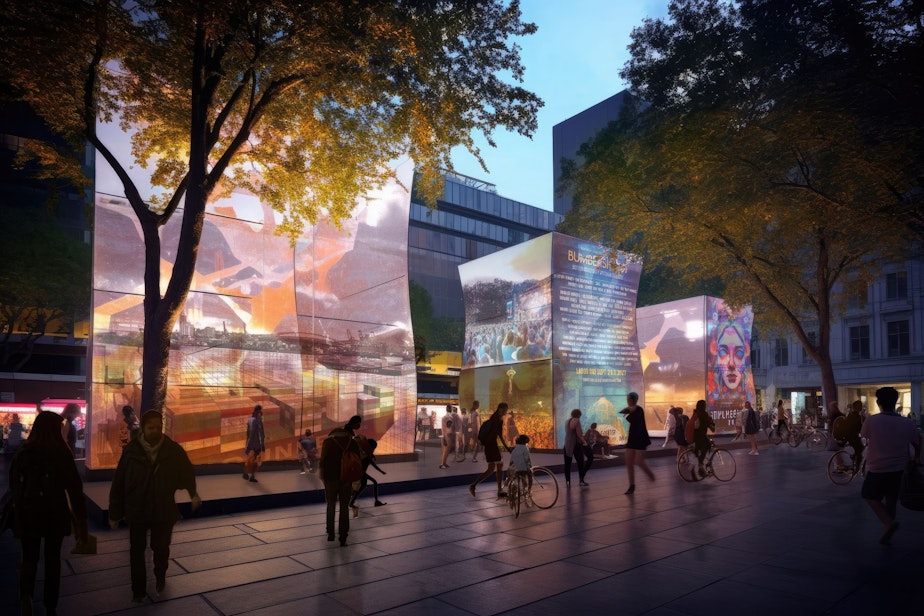
Westlake Park meets Times Square
Imagine Westlake Park with giant jumbo screens showing major sports events. Visitors will get a taste of that in late July during the Women’s World Cup. Why not make screens like that a permanent part of the streetscape, the mayor asks?
Sponsored
Reporter Erica Barnett of PubliCola asked a question about surveillance and privacy concerns that came up around data kiosks in New York. That'll be something to watch.
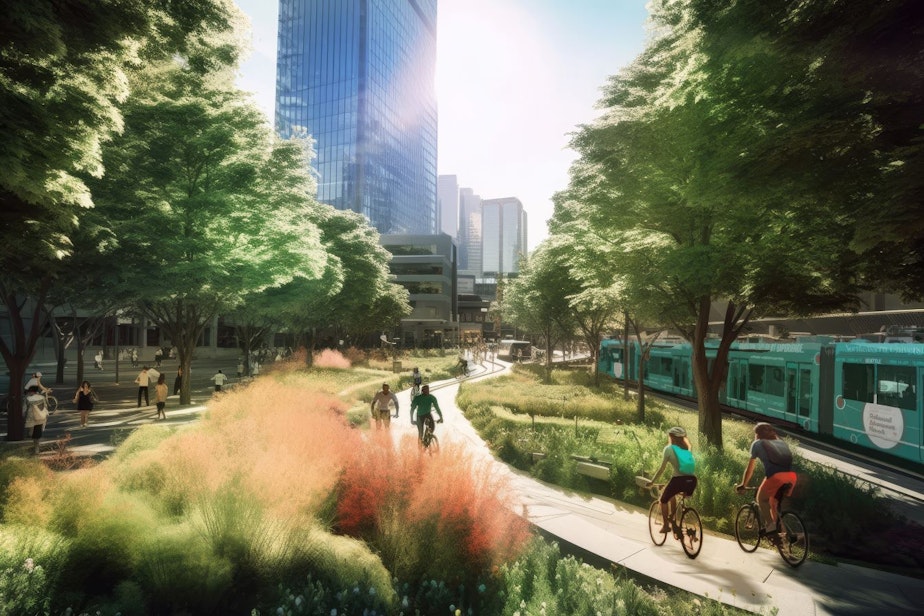
Lid I-5 and put lots of trees on it
Or put trees in other places. Either way, like many of these big ideas, this isn't something the city can fund alone. Still, the mayor is putting the idea out there that downtown could contain an "Urban Forest," maybe in the same spirit with which the Seattle Art Museum created an urban natural beach at the edge of the Olympic Sculpture Park.
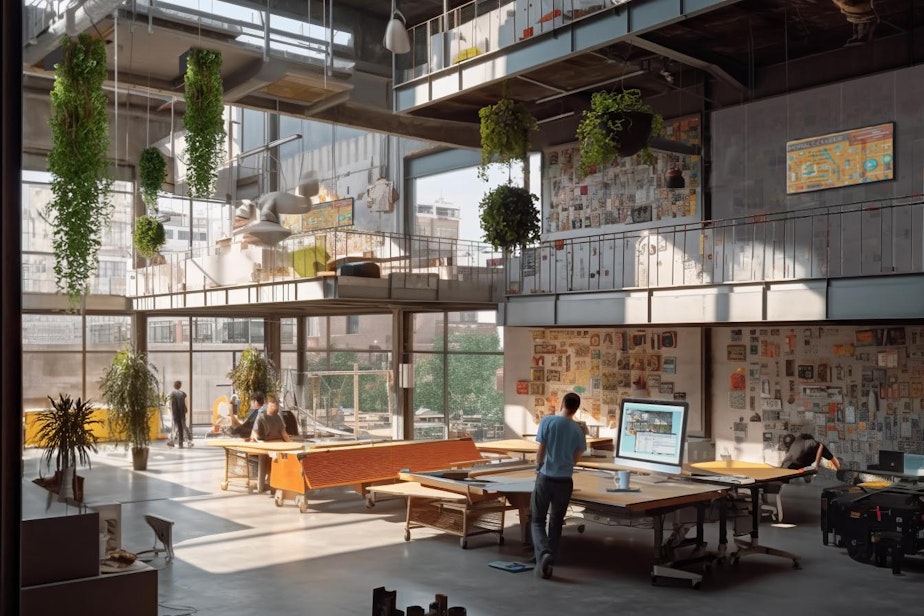
Makerspace Campus
Somewhere between a college robotics lab, a woodshop and a startup incubator, this facility would bring together educational instutions and companies that need workers. Boeing makes planes, and much of Seattle's economy is still populated by people who consider themselves builders of physical things. This could be a place for them to mingle and feed each other.
In this AI-generated image, a student appears to watch helplessly as a grey, self-repairing robot grows in size and takes over one of the balconies.
The Big Picture
The AI-generated images curated by architecture firm Olson Kundig don't represent real projects, but are meant to spark public discussion about what big ideas could unite the city around a long term vision for downtown rooted in Mayor Harrell's Downtown Activation Plan. The hope is that people will come together around some of these ideas, much in the way Seattle was united around the 1962 Century 21 Exposition, which gave birth to the Space Needle.
But that world's fair didn't completely unify people. Critics fought the demolition of homes and a school on the grounds where the fair would go. Backers of the project argued over whether to emphasize the arts, a carnival, or open space.
As protesters over Harrell's treatment of people living in RVs demonstrates, unified visions are hard to achieve, especially around thorny issues. They don't begin to look unified until they're part of the distant past.
More Practical Solutions
The Mayor's plan also includes a long list of far simpler legislative fixes meant to address public safety and add flexibility to the city's zoning code so that buildings can adapt and change.
For example, the mayor wants to:
- Rezone parts of downtown for taller residential buildings.
- Create a Crisis Care Center for adults, and maybe one for youth. Money for this could come from the behavioral health levy approved in April.
- Make it easier still to convert offices into residential towers.
- Waive fees for food trucks, and let them take over the street sometimes for special public events.
- Allow more kinds of uses in vacant storefronts.
- Get more Black-owned and other under-served businesses into vacant storefronts.
- Make it easier to build hotels in Belltown.
As these pass through the city council over the next few months, look to KUOW for further in-depth coverage.




